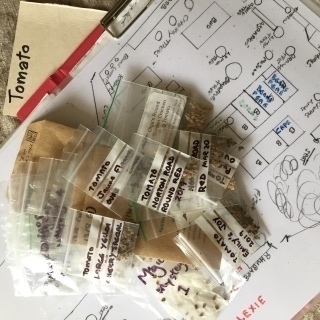 |
|
| > Welcome > Grow and Eat > Plant Food: How to Plan for Tomatoes
|
|
How to Plan for TomatoesNew Zealand is not an island paradise with white sanded beaches and coconut palms around every corner. No, we can’t grow coconuts, mangoes, nor rice here. Although some enterprising soul has started a successful quinoa farm. Yet here in the North Island of New Zealand, we can grow some kind of nutritious and colourful food all year round, yes even in winter. By early autumn most of the hardy varieties of vegetable seeds or seedlings are in their beds, they grow rapidly in the cooling air, almost as if they are singing for joy. No more baskets or bowls of harvested vegetables linger on the kitchen table waiting to be dried or bottled. As the weather cools even more, so the plants in the garden slow in growth until they are sleeping, yet standing tall and proud ready to give us good food when we need it. In my mind the garden is at rest for a little while. There is even a little gap with no seed sowing required. A Process of PraiseAnd then is the joyful time of garden planning! Don’t you just love the joy of garden planning in the coldest months of the year? Yet with bible prophecy unfolding so rapidly, I sometimes feel as if I am living a double existence: On the one hand we humans still need the practical things of life, growing food for instance; yet we know our life may change at any moment. Still around every practical aspect of life, you can find a promise of God for your need every day. So, dear reader, choosing which tomato to grow for the summer ahead can be very simple – or complicated. Apparently, I take the complicated route! But this process is part of praising God to me, like a fine prayer, or a piece of music filled with lilting notes, harmony and rhythm. Please don’t imagine I follow this process rigidly to the letter, but rather practice it year by year in spirit, with thankfulness and joy. Here is my process: 1. Pray for God’s guidance as only our heavenly Father and His Son know what is ahead.
3. Look forward to long range weather forecasts for temperature, wind, rainfall.
And that dear friend, is the rhythm I begin once the waterbath preserver is packed away, the dehydrator moved to its winter home, the jars stacked away, waiting for a dreary moment to burst open a jar of summer tomatoes with its sprig of basil and slivers of garlic to perfume the air. Which reminds me, I need to sow more basil seeds. With thanks to you dear one, may we meet one day on the pearly shores.
Posted: Sat 07 Nov 2020 |
|
|
